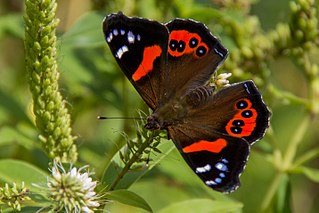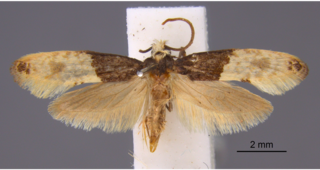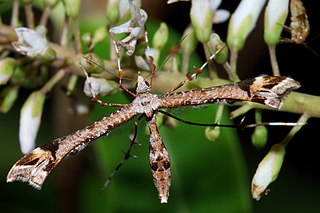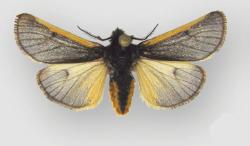
Pieris rapae is a small- to medium-sized butterfly species of the whites-and-yellows family Pieridae. It is known in Europe as the small white, in North America as the cabbage white or cabbage butterfly, on several continents as the small cabbage white, and in New Zealand as the white butterfly. The butterfly is recognizable by its white color with small black dots on its wings, and it can be distinguished from P. brassicae by its larger size and the black band at the tip of its forewings.

The grey pug is a moth of the family Geometridae. It is found throughout the Palearctic region. It is also found in North America. Since it does not place any special demands on climatic conditions, special caterpillar food plants, geological subsoil or the like it is a typical species of almost any Hochstaudenflur, where it occurs in the herb layer, in bushes and even on deciduous trees. It can be found on forest edges and hedgerows, on heath, in rocky places and wetlands, parks and gardens, as well as in villages and town centres.

The map is a butterfly of the family Nymphalidae.

The New Zealand red admiral is a butterfly endemic to New Zealand. Its Māori name is kahukura, which means "red cloak". The red admiral is a member of the family Nymphalidae, the subfamily Nymphalinae and the tribe Nymphalini. There are two subspecies: V. g. gonerilla, which occurs on the mainland of New Zealand, and V. g. ida, which occurs on the Chatham Islands.

Choreutidae, or metalmark moths, are a family of insects in the lepidopteran order whose relationships have been long disputed. It was placed previously in the superfamily Yponomeutoidea in family Glyphipterigidae and in superfamily Sesioidea. It is now considered to represent its own superfamily. The relationship of the family to the other lineages in the group "Apoditrysia" need a new assessment, especially with new molecular data.

The yellow admiral or Australian admiral is a butterfly native to Australia, New Zealand, Lord Howe Island, and Norfolk Islands. The Māori name is kahukōwhai, which means "yellow cloak". The yellow admiral is a member of the family Nymphalidae, the subfamily Nymphalinae as well as the tribe Nymphalini.

Anthophila fabriciana, also known as the common nettle-tap, is a moth of the family Choreutidae first described in 1767 by Carl Linnaeus. The moth can be found flying around stinging nettles during the day.

Polygonia egea, the southern comma, is a butterfly of the family Nymphalidae. It is found in southern Europe.

Papilio anactus, the dainty swallowtail, dingy swallowtail or small citrus butterfly is a medium-sized butterfly from the family Papilionidae, that is endemic to Australia.

Trichophaga tapetzella, the tapestry moth or carpet moth, is a moth of the family Tineidae, commonly referred to as fungus moths. It is found worldwide.

Eriocrania unimaculella is a moth of the family Eriocraniidae found in Europe. It was first described by the Swedish naturalist Johan Wilhelm Zetterstedt in 1839. The larvae feed inside the leaves of birch, making a mine.

Prochoreutis myllerana, Miller’s nettle-tap or small metal-mark, is a moth of the family Choreutidae found in Asia and Europe. Miller's nettle-tap was first described by Johan Christian Fabricius in 1794 from a specimen found in Sweden.

Amblyptilia falcatalis, the common Hebe plume moth, is a species of moth of the family Pterophoridae. This species was first described by Francis Walker and is endemic to New Zealand. This species can be found in both the North and South Islands. The larval host plants are in the Veronica genus and include Veronica stricta,Veronica salicifolia,Veronica elliptica, Veronica macrocarpa and Veronica speciosa. This moth likely has two broods a year and adults have been observed all year round.

Sevenia boisduvali, the Boisduval's tree nymph, is a butterfly in the family Nymphalidae. There are four subspecies; all native to Africa.

Choreutis nemorana, the fig-tree skeletonizer moth or fig leaf roller, is a species of moth of the family Choreutidae.
Zodia scintillana is a moth of the family Choreutidae. It is known from Central and South America, including Costa Rica. The habitat consists of tropical rain forests.
Anthophila alpinella is a moth of the family Choreutidae. It is found from the north-eastern United States and southern Canada to British Columbia, the Rocky Mountains, and along the Pacific Coast to Marin County, California.

Andesobia jelskii is a species of moth of the subfamily Arctiinae first described by Charles Oberthür in 1881. It is found in the Department of Junín in Peru.

Hierodoris atychioides is a moth of the family Oecophoridae. It was described by Arthur Gardiner Butler in 1877. The female holotype specimen held at the Natural History Museum, London. This species is endemic to New Zealand, and can be found in the North, South and Stewart Islands. The larvae form webs of silk attached to frass and leaves on their hosts in which they shelter, often in the company of other larvae in their species. Their feeding habits have not been observed in detail but Hoare hypothesises the larvae may feed on dead or dying leaves. The larvae feed on a wide range of trees and shrubs, including Dacrydium cupressinum, Prumnopitys taxifolia, Dacrycarpus dacrydioides, Libocedrus bidwillii, Cupressus macrocarpa, Leptospermum scoparium, Kunzea ericoides, Ozothamnus leptophyllus, Abies, Picea, Pinus and Thuja species. Although they are regarded as a pest of exotic forests in New Zealand, the economic damage the larvae cause is minimal and they tend to be controlled only by their natural enemies. Larval enemies include the parasitic flies Trigonospila brevifacies and Pales funesta as well as parasitic wasps including Xanthopimpla rhopaloceros. The adult moths are day flying and are most common during the months of December and January. This species is variable in appearance as larvae, pupa and as adults, and it has been hypothesised that it is in the process of speciation.

Proteodes carnifex is a species of moth in the family Depressariidae. It is endemic to New Zealand. Both the larvae and the adults of this species are variable in appearance. However the adults are normally easily identified as the outline is characteristic and the size is consistent. In appearance, adult moths mimic the leaves of their larval host plants. This species has been found near Wellington in the North Island, the tableland of Mount Arthur, in the Canterbury region, Arthur's Pass and at Lake Wakatipu in the South Island. The larval hosts of this species are southern beech trees, particularly black beech and mountain beech but larvae have also been found on Nothofagus fusca, Nothofagus truncata and Nothofagus menziesii. The female moth deposits her eggs individually on the underside of native beech tree leaves. Once hatched the larvae feed on those leaves through winter and spring and then pupate in January. The adult moth emerges from the pupa after fourteen days and is on the wing from January until April. They are day flying moths and are not attracted to light. Various insects parasitise the larvae of this moth including several species of wasp as well as flies including the endemic fly, Pales funesta.























